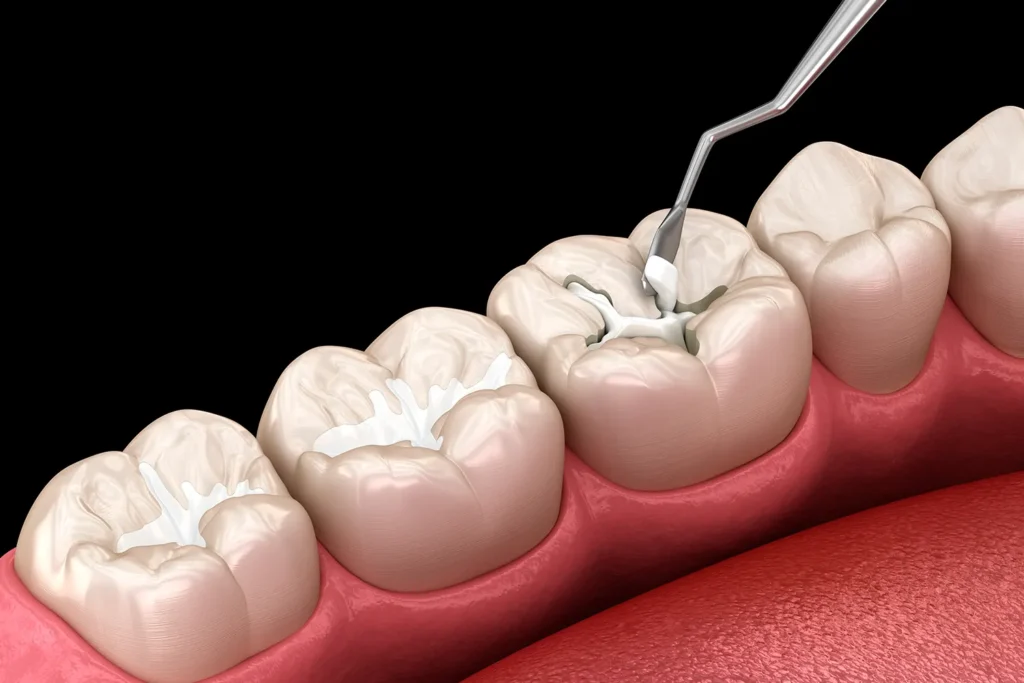
Dental Sealants
Dentists recommend a dental procedure to avoid back teeth cavities, which are caused by bacteria. The method works like a barrier, protecting the grooves and pits of teeth from food particles and bacteria that may leads to decay.
What are Dental Sealants?
These are thin plastic coatings applied to the chewing surface of the back teeth, including premolars or molars, to prevent cavities. These dental procedures are safe, cost-effective, and painless, especially for teenagers and children. Keep in touch with a qualified team of Butternut Family Dentistry to keep your oral health intact.
How common is this dental process?
Sealants are still the most common and recommended treatment for preventive dentistry and caries prevention. In the United States of America, approximately 42% of children (age groups 6-11) and 48% (age groups 12-19) have this dental procedure on their permanent/ adult teeth.
How does it work?
Initial cleaning and setup:
You need to clean your teeth thoroughly and dry them. To roughen the surface, you may apply a slightly roughened paste or place a piece of cotton gauze in the specific area to keep the surface of your teeth dry. Dentists also use acid etching (a small amount) and paint it on a particular chewing surface for abrasion.
Application/Process:
Hygienists may apply/paint the sealant material onto your enamel, which bonds to the tooth. As it is, liquid plastic usually flows in pits and into grooves. The correct procedure to form a protective layer by curing the polymerized substance is to use a shining dental curing light (usually a special type of blue light).
Protection:
This procedure can prevent food particles, bacteria, and cavities from filling grooves.
Benefits of this procedure:
Brushing and flossing teeth can’t always cover all crannies and nooks. Oral hygiene removes food, debris, and plaque from teeth’s smooth surfaces only, although this process covers all vulnerable areas, excluding cavities, food particles, and plaque. Keep in touch with a qualified team at Butternut Family Dentistry to keep your oral health intact.
Long-lasting:
Sealants can last several years, at least five years, providing ongoing protection, but they need to be replaced periodically.
Cost Effective:
Treating Cavities with fillings is more expensive than sealants, which are more cost-effective.
Painless:
This procedure is smooth, quick, and painless.
Cover All Ages: Suitable for everyone:
Most Dentists use this procedure for children, but adults can utilise the sealant equally beneficial for all ages.
Cavity Prevention:
Most commonly, sealants specifically prevent cavities in back teeth, where decay is very common. They also reduce the risk of cavities.
Things you should know about Dental Sealants:
You should also know a few things about this procedure, it lasts about 5 years and must be replaced occasionally. It doesn’t help with teeth that already have dental fillings or decay. The dental procedure should be placed properly to prevent bacteria from being sealed in, which may cause cavities between the tooth surface and the sealants.
Who needs Dental Sealants?
Children, Teenagers:
Equally, this dental procedure for teens and children is the most recommended treatment for tooth decay, especially in the back teeth. Although, in general, it’s recommended as a good solution, mostly for anyone dealing with tooth decay, especially in the back teeth. Typically, Hygienists suggest that children should get sealants on permanent premolars and molars as soon as their teeth come in. In this way, this dental procedure prevents cavities from age 6 to 14, such as deep depression of teeth in babies and grooves. This procedure is more appropriate and good for the baby’s primary teeth. Because the baby teeth hold space for permanent adult teeth, it’s important and necessary to keep these baby teeth healthy to avoid too early loss.
Adults:
In adults, it is only beneficial for those without dental fillings and decay in molars.
Maintenance and aging:
This is a typically good option and also lasts for several years, at least five. You can check it up during your regular dental check-up if the doctor’s advice can be replaced with the doctor’s recommendations. Brushing and flossing are good oral hygiene habits and are most important, even though you have this dental procedure, to maintain your oral health.
Any preparation required for sealants:
There is no preparation required for this procedure; it can be placed by your dentist or hygienist during your routine visit or regular check-ups with your doctor. Before applying for this dental procedure, consult with your doctor and follow the instructions. One common advice is to clean your teeth properly to avoid bacteria from getting trapped between this dental procedure material and your tooth surfaces.
FAQs
How much do Dental Sealants cost?
The average cost per tooth for this procedure is about $30-$40, but it can depend on your location and type of insurance. In some states, this procedure is covered. Butternut Family Dentistry’s qualified team is the best team for keeping your oral health intact cost-effectively. Butternut Family Dentistry treats you like family, concerned for your oral health. Butternut Family Dentistry offers the best services for dental prevention.
What are the downsides of Dental Sealants?
You must visit your doctor regularly for check-ups. The risk of tooth decay is there. This procedure also contained Bisphenol (BPA or A), but at a very low level. The ADA (American Dental Association) has confirmed that it’s safe.
What is the success rate of Dental Sealants?
The ADA (American Dental Association) mentioned that this procedure can lessen the risk of decay by up to 75%. Another report states that its effectiveness is 11%- 51%.
Can you still get cavities with Dental Sealants?
This procedure prevents cavities, but it still does not completely remove the risk of decay. There is a risk if the procedure is not properly done.
Why are Dental Sealants done with adults?
This procedure is only done with those adults who have never had fillings.
